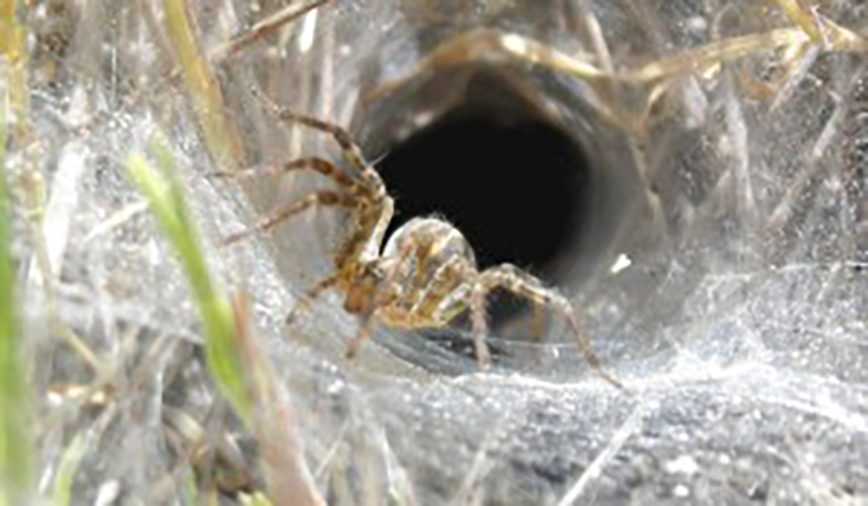August 17, 2012
With a temperature forecast in the 70s today, it sure doesn’t feel much like August. But certain signs of the season are undeniable. Cicadas are buzzing, prairies are blooming and spiders, bless their little cardiac marks, are everywhere.
Take a walk through any of the TriCity downtowns and you’ll see the work of orbweavers strung between windowsills, walls and light fixtures. In fact, if you check your own outdoor lights you’ll likely see the spiraled webs of still other representatives of this most famous spider group.
But if you look down a little, toward the bushes and lawn, you’ll see some even more incredible creations.
The grass spiders, undersung members of the class Arachnida, have been busy this summer, slinging their thick mats of white silk across wide expanses of shrubbery, grass and, in at least one case, the indented space on the back of a garage door. (Thanks to my sharp-eyed friend Brianne for pointing this one out.)
The size and strength of these webs are impressive, for sure, but what’s really cool is the little tunnel at one end. That’s the spot the web’s creator weaves just for herself. (That’s right, the architects of these remarkable residences are females; male grass spiders are more nomadic, spinning marginal webs as they spend the summer on the move in search of a mate–in essence “cruising for chicks.”)
Grass spiders are members of the family Agelenidae, the funnel-web
weavers. Mostly medium-sized (although some species are quite tiny), these spiders are often mistaken for wolf spiders, since both have a longitudinal stripe down their backs. The main difference is that grass spiders are web-based critters while wolf spiders are ambush predators that hide under rocks or in crevices instead of webs.
If you compare abdomens (and I realize, for some folks, that’s a really big IF), you’ll notice that grass spiders have two long projections down at the rear; wolf spiders do not. These structures are called spinnerets; they are the spider’s web-spinning organs and there typically are six total. If you can remember that grass spiders are web spinners, and thus have prominent spinnerets, you can remember the difference between wolf spiders and grass spiders.
If I were a spider, Agelenopsis is what I’d want to be.
That sheet web with the funnel at one end is a great place to hang out, providing a certain amount of privacy as well as protection from the elements. Even better, when it’s time to eat, meals are easy as pie.
A silken barrier just above the funnel functions as a nearly invisible food-snaring net. Unsuspecting insects fly or tumble into the net, then fall smack down in front of the waiting spider—kinda like having a pizza fall down from your living room ceiling.
Well, with one major exception. While pizzas need little subduing, insect meals are a little more work. When a bug drops in, the grass spider rushes out of her funnel and delivers a swift bite, injecting venom into the six-legged “pie.” She then drags her “pizza” prey back into the funnel for a quiet dinner at home.
Dining indoors instead of al fresco gives the spider a couple of advantages. One, she is not exposed to other creatures who might consider her prey of their own. And two, other insects can’t see what happened to their comrade, thus increasing the chances, for the spider, of more food falling from the sky.
While female grass spiders are pretty well provisioned, males have it a little tougher. Web-spinning is not their forte. Dancing, though, is.
Female spiders of many species have well-deserved reputations for being cannibalistic. Larger than males, more than a few have been known to snack on their mates after courtship wraps up. Saddled with this threat, male spiders have come up with a fantastic repertoire of activities all designed with the singular purpose of self preservation.
Some species physically restrain the female’s fangs, so they remain safely out of the way; certain others present the females with a nuptial gift—a wad of silk that may or may not contain a succulent prey item inside. Either way, the female remains occupied unwrapping her “present” and thus unlikely to sink her fangs into her suitor.
Male grass spiders, however, don’t have modified structures for defeating fangs, nor are they much good at wrapping presents. But boy, can they dance.
When a male Agelenopsis encounters a female’s funnel web, he begins a series of movements intended to not only announce his presence, but also lull the female from a state of high alert to eventual quiescence. He quivers his legs, which causes the web to vibrate, and sways his abdomen in a sort of belly dance. These movements result in a release of chemicals called pheromones that cause the female to become passive and lets him get down to business. (For interpretive purposes, you can think of this ritual as a spidey version of the phrase, “Candy is dandy but liquor is quicker.”)
Although grass spider activity is nearing its peak, it’s a pinnacle that’s short lived. These entertaining spiders have a one-year life cycle that culminates with the production of egg sacs. Mom and pop fade away, their dancing days over, and the wee ones bide their time.
With the return of warm weather, little grass spiders will burst forth and the whole cycle, pizzas and pheromones and all, will begin once again, in a shrub or lawn or garage door near you.
Pam Otto, oddly hopeful that one day pizzas will indeed fall from the sky, is the manager of nature programs and interpretive services for the St. Charles Park District. She can be reached at 630-513-4346 or potto@stcparks.org.

